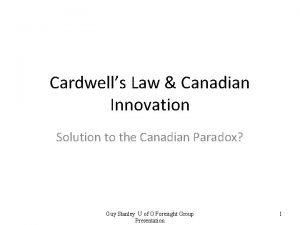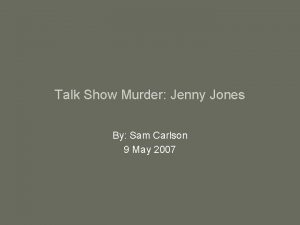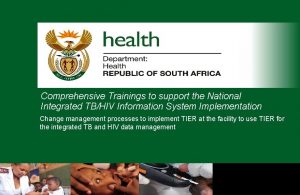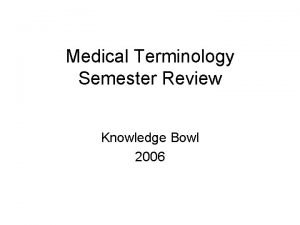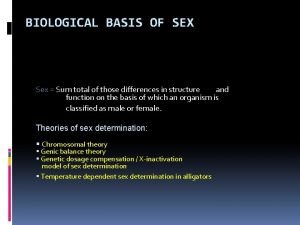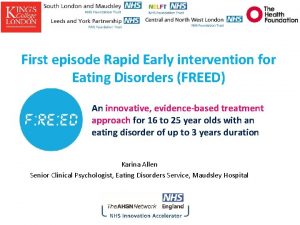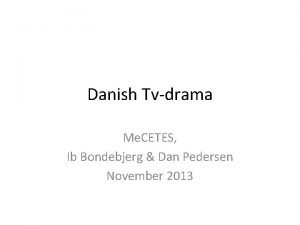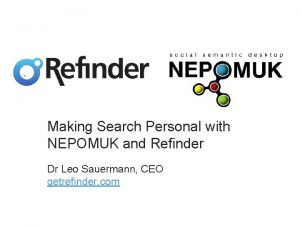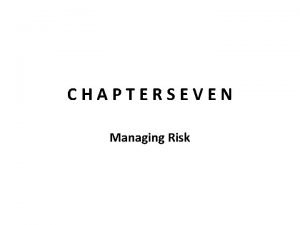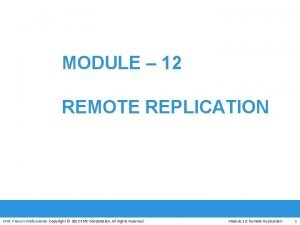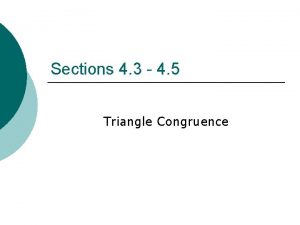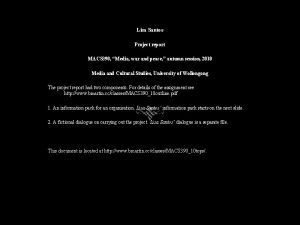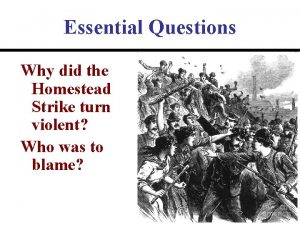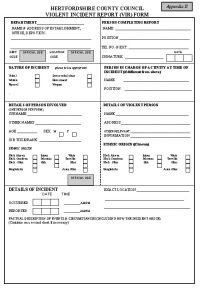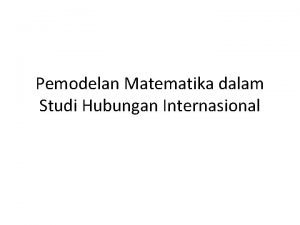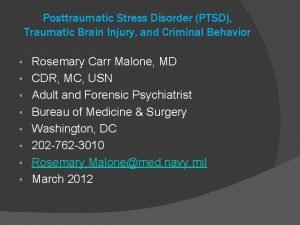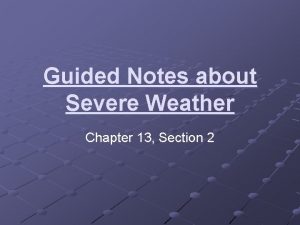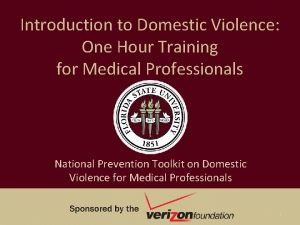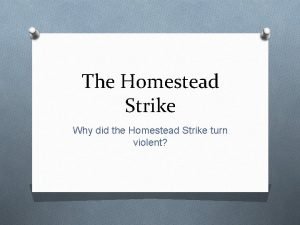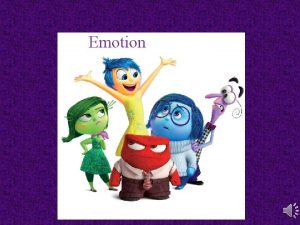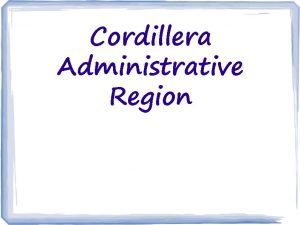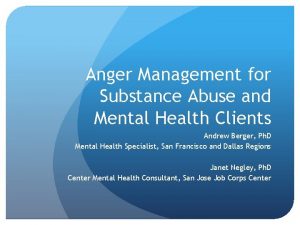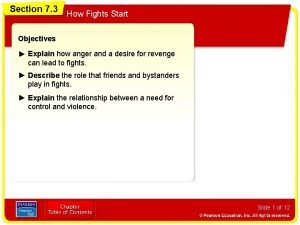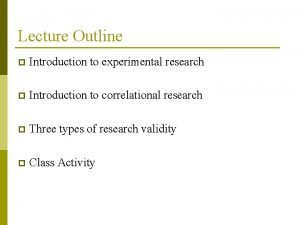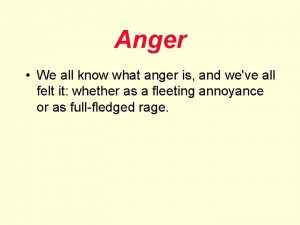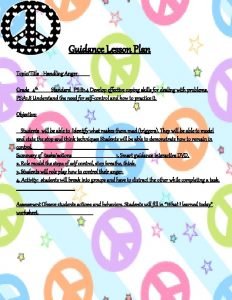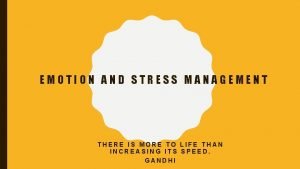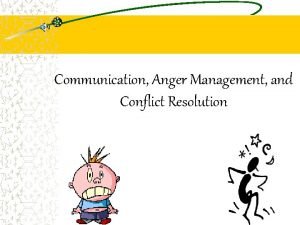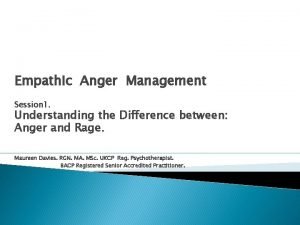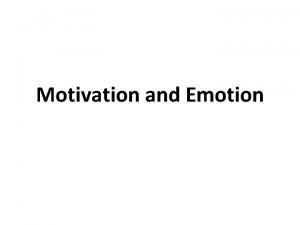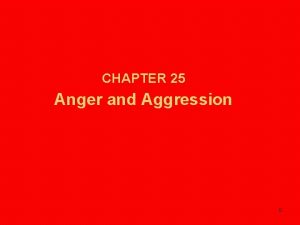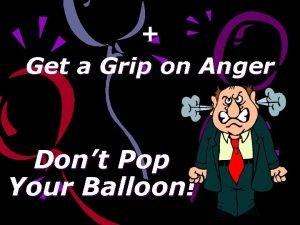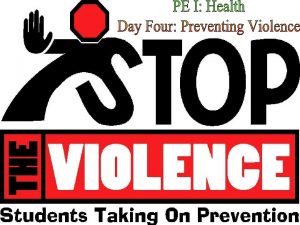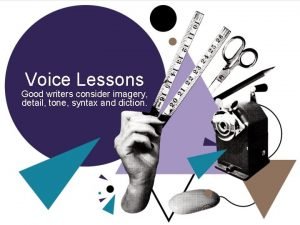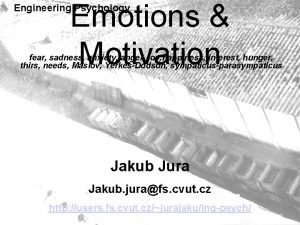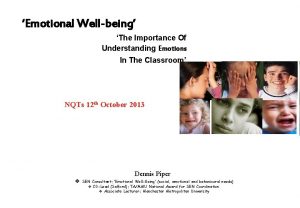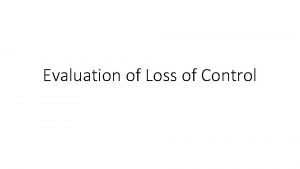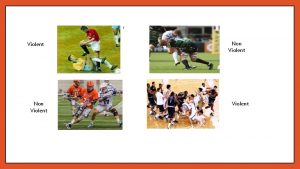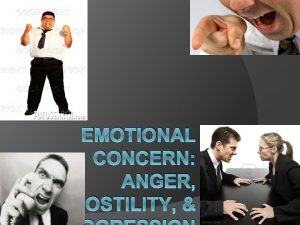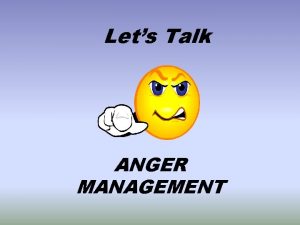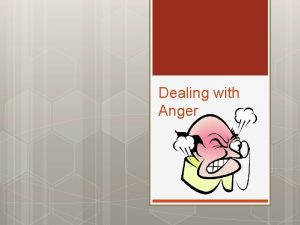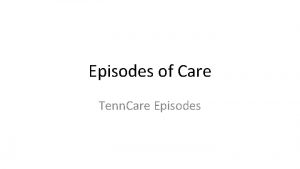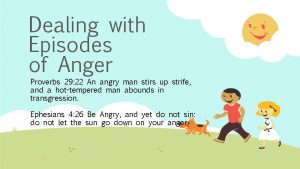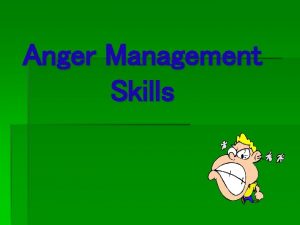Proven Strategies To DeEscalate Anger Violent Episodes Cardwell































































































- Slides: 95

Proven Strategies To De-Escalate Anger & Violent Episodes Cardwell C. Nuckols, Ph. D cnuckols@elitecorp 1. com

WHY CHANGE • • • Responsibility and blame Other condemnation Self-righteousness Cathartic expression Short-term reinforcement

THE ART AND SCIENCE OF HEALING CAN YOU REMEMBER AN EXPERIENCE WHEN SOMEONE (A CLIENT, FRIEND OR CHILD) CAME TO YOU WITH AN UNSOLVABLE PROBLEM AND IN YOUR PRESENCE CAME UP WITH THE SOLUTION WITHOUT YOU SAYING A WORD?

THE ART AND SCIENCE OF HEALING • ENTRAINMENT • COHERENCE • SEEING THE LOVE AND BEAUTY INSIDE ONE WHO CANNOT SEE IT INSIDE OF HIM/HER SELF

THE ART AND SCIENCE OF HEALING • Heart-rhythm synchronization can occur in interactions between two people and also between a person and their pets • The top of the graph shows the dog’s (Mabel) heart rhythm shift when the boy (Josh, shown in the lower part of the graph) entered the room, sat down and proceeded to consciously experience feelings of love towards Mabel.

THE ART AND SCIENCE OF HEALING • When Josh consciously felt feelings of love and care towards his pet, his heart rhythms became more coherent, and this change appears to have influenced Mabel’s heart rhythms, which then also became more coherent. There was no physical contact between them.

THE ART AND SCIENCE OF HEALING

THE ART AND SCIENCE OF HEALING

THE ART AND SCIENCE OF HEALING

VIOLENT BEHAVIOR MULTIDETERMINED

VIOLENT BEHAVIOR MULTIDETERMINED • The failure of “top-down” control systems in the prefrontal cortex to modulate aggressive acts that are triggered by anger provoking stimuli appears to play an important role. An imbalance between prefrontal regulatory influences and hyperresponsivity of the amygdala and other limbic regions involved in affective evaluation are implicated.

VIOLENT BEHAVIOR MULTIDETERMINED

VIOLENT BEHAVIOR MULTIDETERMINED • Insufficient serotonergic facilitation of “top-down” control, excessive catecholaminergic (norepinephrine, etc. ) stimulation, and subcortical imbalances of glutamatergic/gabaminergic systems as well as pathology in neuropeptide systems involved in the regulation of affiliative behavior may contribute to abnormalities in this circuitry

VIOLENT BEHAVIOR MULTIDETERMINED

VIOLENT BEHAVIOR MULTIDETERMINED

VIOLENT BEHAVIOR MULTIDETERMINED • Thus, pharmacological interventions such as mood stabilizers, which dampen limbic irritability, or selective serotonin reuptake inhibitors (SSRIs), which may enhance “top-down” control, as well as psychosocial interventions to develop alternative coping skills and reinforce reflective delays may be therapeutic.

VIOLENT BEHAVIOR MULTIDETERMINED

VIOLENT BEHAVIOR MULTIDETERMINED • The critical role of the prefrontal control in aggressive and dyssocial behaviors, consistent with the frontal cortex modulating subcortical behavior, was first recognized in the context of prefrontal cortical lesions resulting in disinhibited aggressive behavior. These lesions may occur as a result of trauma, tumors, or even metabolic disturbances that affect the prefrontal cortex. A prime example of this disinhibition is found in the often cited case of Phineas Gage

VIOLENT BEHAVIOR MULTIDETERMINED • Phineas Gage, a dependable, stable railroad worker who was injured by a tamping rod that penetrated his skull through his orbital frontal cortex (the anterior and mesial aspects and anterior cingulate). He became angry, irritable, and showed poor social judgment following the injury. • Larry J. Siever, M. D. Neurobiology of Aggression and Violence. Am J Psychiatry 2008; 165: 429 -442.

VIOLENT BEHAVIOR MULTIDETERMINED • Reduced opioids may be associated with increased separation/abandonment distress and rejection sensitivity that may heighten the likelihood of aggressive behavior. Reduced presynaptic opiate activity may upregulate postsynaptic μ-opioid receptors, and thus dramatic relief of pain may result when opiates are released in the context of self-injurious behavior. • Larry J. Siever, M. D. Neurobiology of Aggression and Violence. • Am J Psychiatry 2008; 165: 429 -442. doi: 10. 1176/appi. ajp. 2008. 07111774

ANGER AND AGGRESSION A PROCESS NOT AN EVENT

I/E

SELF-IMAGE • Violation of our image of ourselves (ego) leads to……. • Defenses in the form of narcissistic character defects such as judgmentalism and anger fueled by… • A fear of losing control

SELF-IMAGE • Expectations – Unfulfilled expectations can lead to anger and resentment • Victims stance – Could have, should have, ought to have been • Example-Being rejected

ANGER AND FEAR • Letting go is a mechanism of the mind and causes a sense of relief and lightness – Example: I was with a friend and we were talking about all of the problems we had to deal with on a work project. We both broke out in laughter. The problems still existed but they were no longer our problems (i. e. some deficit in us) – Technique: Letting go consciously and frequently at will • NO LONGER THE VICTIM

ANGER AND FEAR • THREE MAJOR WAYS WE HANDLE FEELINGS – SUPPRESSION AND REPRESSION • Most common • Associated with unconscious programs • Pressure of suppressed feeling is later felt as irritability, headache and tension in neck and back, mood swings, cramps, insomnia, somatic and autoimmune disorders • Associated with guilt and fear • Denial and projection often used as defense systems

ANGER AND FEAR – SUPPRESSION AND REPRESSION • Projected into the world as “them” leading to blame and possible anger and aggression – EXPRESSION • Feeling is vented, verbalized or stated in body language and acted out – Gets enough feeling out so the rest can be suppressed • This doesn’t make the feeling go away as some have taught – ESCAPE • Avoidance of feelings through diversion

ANGER AND FEAR – ESCAPE • Entertainment and liquor industry are socially condoned as is workaholism • Drugs, food, gambling, and sex are other means of escape • PEOPLE ARE DESPARATE TO REMAIN UNCONSCIOUS… – Flick on the TV – Text and text some more – “Go…Go” requires a lot of energy

ANGER AND FEAR • WHEN YOU LET GO OF FEELINGS THE ENERGY IS SURRENDERED AND THE NET EFFECT IS DECOMPRESSION • The source of stress is internal • The more fear we have on the inside, the more our perception of the world (worldview) is fearful and our expectancy guarded

ANGER AND FEAR • Stress results from the accumulated pressure of our repressed and suppressed feelings that seek release – We even suppress and repress positive feelings such as love • External events are the trigger • Stress is an emotional reaction to a stimulus determined by our belief systems and their associated emotional pressures

ANGER AND FEAR • MECHANISM OF LETTING GO – Become aware of a feeling (sensation) without labeling the sensation, venting, resisting, moralizing and judging – Ignore all thoughts as they are just excuses and get us nowhere – Let the sensation in and just stay with it – Let it run it’s course without trying to make it different; just let the energy run out – If feeling returns or continues there is more to be surrendered

ANGER AND FEAR • MECHANISM OF LETTING GO – Identify the ego’s unconscious program for happiness (the old belief system based in fear) – As the unconscious programs are released we release our attachments – When we have released our attachments… “IN THIS WORLD BUT NOT OF IT” – Letting go of negative feelings is the undoing of the ego

ANGER AND FEAR • FEELINGS (SENSATIONS) – First accept the feeling without resistance, condemnation or a need to label the feeling • WELCOMING PRAYER – Let it be while it empties out energy – Later the thoughts can be looked at and their character changed – If feeling has totally been surrendered and let go usually all thoughts attached to it will disappear replaced by a concluding thought which handles the matter quickly

ANGER AND FEAR • Many live their life regretting the past and fearing the future therefore, unable to experience the peace of the moment • Victor Frankl- “Logotherapy”, “Man’s Search for Meaning” – To give the past a different meaning and to look for the hidden gift in it – Emotional events and traumatic occurrences will change considerably if a new meaning is placed around them

ANGER AND FEAR • “Everything can be taken from a man but one thing: the last of the human freedoms-to choose ones attitude in any given set of circumstances, to choose one’s own way. ” Frankl, 1959 • Every life experience contains a hidden lesson (EX-SORROW) • When we discover this a healing takes place

TREATMENT OF FEAR • MAY PRESENT AS ANXIETY OR ANGER �Want energy but not feeling �Disassemble �Physical symptoms �Can you handle them? �Emotional symptoms �Can you handle them? �Not experiencing fear just a bunch of symptoms �“Fear is not you, it is just a symptom

BRIEF ASSESSMENT • Information about past and current behavior – Client/Patient – Friends and family • Review of past treatment – Successful – Unsuccessful • Clinical evaluation over time – Medical – Psychosocial

RISK ASSESSMENT • Documentation – Should be a separately labeled narrative in the clinical notes – Should be based upon clinically established risk and protective factors. – Many of factors overlap with those of suicide so can be combined into a single assessment

RISK ASSESSMENT • Documentation-Example of admission note “Patient delivered by police secondary to domestic dispute. Risk factors: history of domestic violence, owns several handguns, alcohol and cocaine intoxication, paranoid delusions regarding partner, threatening suicide in emergency room. Protective factors: currently detained in structured environment. ”

RISK ASSESSMENT • Documentation- Example of discharge note “Patient currently denies both suicidal and homicidal ideation, delusional symptoms resolved, intoxication and withdrawal managed, receiving appropriate medication, safety plan developed, agrees to follow-up chemical dependency and marital counseling, handguns removed from home. Claims he is hopeful about the future. Based on these factors, the patient no longer poses a high risk of violence. ”

MANAGING RISK • Give yourself time to review your options • Consult a colleague • Develop a safety plan – Developed with the patient to reduce violence risk and might include avoiding triggers, using mindfulness, how and whom to ask for help; include caregivers or significant others in the discussion • Assess level of care – Increased intensity or increasing number of outpatient contacts; telephone check-ins; for non-adherent patients outpatient commitment might be viable in some states

MANAGING RISK • Reassess medications • Be informed about medication risks – Some medications associated with increase in violent acts; utilize the website for the Institute for Safe Medication Practices (www. ismp. org); subscription required – See Exhibit One • Refer when needed – If patient requires treatment in areas where you are not well trained consider referral

MANAGING RISK • Guns – Understand what a gun means to the individual (for example, a veteran who has been in combat) – Document a firearm disposition plan – If will not relinquish guns they might agree to place them with a friend or remove the ammunition – Gun safes or trigger locks

CLINICAL PEARLS FOR RISK ASSESSMENT • ASK ABOUT SLEEP – Decades ago sleep problems were identified as a short-term (one year) risk factor (Fawcett et al. Am J Psych. 1990: 147(9): 1189 -1194. ) – Recent studies also emphasize sleep disturbances as risk factor (Pigeon, WR et al. Am Journal Pub Health; 2012; 102(s 1): S 93 -S 97. ) – Importantly, even after controlling for depression, hopelessness and alcohol problems, sleep was identified as a risk factor – No stigma attached to sleep

CLINICAL PEARLS FOR RISK ASSESSMENT • HIGH ANXIETY – Anxiety and agitation can mediate the change from thinking about suicide to acting on those thoughts – Anxiety Disorders strongly associated with suicide (Nock, MK et al. Mol Psychiatry 2010; 15(8): 868 -867. ) – It is not unusual for a patient who does not appear anxious to express profound internal agitation/anxiety • This can be described as anguish or psychache – “Do you feel like you are crawling out of your skin? ” – “Do you feel like you are about to explode? ”

CASE STUDY 29 yo male (Marcus) was physically abused by his father. When his father was drunk he would hit Marcus with a belt. At age 12 Marcus made a decision to never let anyone hurt him again. From that point on whenever he felt threatened by a male authority figure he would “get in their face”.

CASE STUDY 27 yo female (Gina) would listen to her parents scream obscenities and hit each other. One day when she was 11 yo she decided that she would no longer put up with the situation. Every time her parents would fight and scream at each other, she would run away from home.

LEARNED COPING AND SURVIVAL SKILLS • Fear or threat (real or perceived) of being out of control leads to: – Withdrawal – Attack of others – Avoidance – Attack of self • “Freeze, Flight or Fight”

LEARNED COPING AND SURVIVAL SKILLS Clinical Example of Vertical Integration • Can be used with anger and many Anxiety Disorders where lower brain overrides cortical areas • “Checker System” – Amygdala – Basal Ganglia – Brain Stem

LEARNED COPING AND SURVIVAL SKILLS • “Checker System” – Scans – Alerts – Motivates • Helping the client have a different relationship with themselves – Psychoeducation – Promotes integration

LEARNED COPING AND SURVIVAL SKILLS • Intervention – Personify the “Checker” – Observe what is going on • Cortex • Discernment – Teach self-regulation strategies • Breathing

LEARNED COPING AND SURVIVAL SKILLS – Promote Dialogue • Have Cortex communicate with subcortical areas – “Thank you for trying to keep me safe” – “You are my friend” – “Here is the deal, we need to talk about being safe” (contingent communication with self) – Cortex and “Checker” as a team • Convince “Checker” that it does not have to be hyperactive

NON-PHARMACOLOGICAL MANAGEMENT • Don’t Personalize • Understand your personal reaction to anger • Assess the environment for potential danger • Know where the client is at all times • Keep an appropriate distance

NON-PHARMACOLOGICAL MANAGEMENT • Validate the client • Shift from Emotional to Cognitive or Behavioral Stance – What lead up to you feeling this way? • Give the client a sense of being in control • Clear the area of other clients or move client to safe place

CASE STUDY Larry was a 23 yo alcoholic and addict. His therapy group had a new therapist and before he even met therapist he looked at him and said, “I’m going to break your_______ head. ” What would you do in this situation?

CASE STUDY • Larry: “I’m going to break your___head. ” • Therapist: “Whatever you do don’t stop behaving the way you are now because you know and I know that it saved your life-didn’t it? • Therapist: “I’d like to talk to that part of you that made a conscious decision to never let anyone hurt you again. ”

EMPIRICALLY PROVEN STRATEGIES • Relaxation – Reduce physiological and emotional arousal • Cognitive – Reduce anger inducing information processing – Increase problem-solving ability • Behavioral – Teach adaptive behaviors

RELAXATION THERAPY • Start early • Techniques include: – Control breathing – Voice tone and tempo – Progressive relaxation – Caution with mental imagery

MANAGING NEGATIVE FEELING STATES • TWO MINUTES OF SILENCE – The auditory cortex has a separate network of neurons that fires when silence begins – Two hours of silence per day prompted cell development in the hippocampus – Silence helps newly generated cells to differentiate into neurons and integrate into the system – Creates a state of “environmental enrichment” – Two minutes of silence allows the “default mode”situated in the prefrontal cortex- to activate

MANAGING NEGATIVE FEELING STATES • TWO MINUTES OF SILENCE (continued) – The “default mode” gathers and evaluates information. Focused attention curtails this scanning activity – It is observed most closely during the psychological task of reflecting on one’s personality and characteristics (self-reflection) – It integrates external and internal information (Joseph Moran, Frontiers in Human Neuroscience, 2013) Gross, DA. “This is Your Brain on Silence. ” Brain in the News. September 2016, pgs. 5 -6.

MANAGING NEGATIVE FEELING STATES • BREATHING FROM YOUR HEART (HEARTMATH) (continued) – The breathes should be a little deeper than usual • 5 -6 seconds on the in-breath and 5 -6 seconds on the out-breath – Appreciate the differences in your feeling state • APPRECIATION BREATHE – 2 -3 times per day – Bring into your mind something or someone you appreciate

MANAGING NEGATIVE FEELING STATES • APPRECIATION BREATHE (continued) – Might consider using a nice note or email from a friend that you carry with you – Could be a prayer or Bible verse – Discern the changes you experience as you read or recall the positive experience • BE OF SERVICE – “I’VE LEARNED THAT PEOPLE WILL FORGET WHAT YOU SAID, PEOPLE WILL FORGET WHAT YOU DID, BUT PEOPLE WILL NOT FORGET HOW YOU MAKE THEM FEEL. ” Maya Angelou

MANAGING NEGATIVE FEELING STATES • BE OF SERVICE (continued) – Focus on you environment – Kindly act to be of service to people, places and things – Notice how you feelings change as you direct love outward – The more you give of yourself the more we are filled with Love (kenosis)

MANAGING NEGATIVE FEELING STATES • OTHER APPROACHES – Grounding – Taking a walk in nature – Playing with dogs, cats and small children – Taking a shower – Writing in a journal – Listening to certain music such as classical, improvisational jazz, Tibetan Incantations, Gregorian Chant, etc. – Physical exercise

CASE STUDY Samantha was a 17 yo female who smoked marijuana because it helped her to “mellow-out”. In early recovery she was having problems with anxiety and anger. Her therapist taught her several strategies that involved tensing and relaxing muscles along with cognitive and behavioral techniques.

LABELING FEELINGS • Verbalizing our feelings and labeling emotions makes them less intense. • Photograph of an angry or fearful face causes increased activity in the amygdala – Creates a cascade of events resulting in “fight or flight” response • Labeling the angry face changes the brain response

COGNITIVE THERAPY SITUATION AUTOMATIC THOUGHT BEHAVIORS, EMOTIONS, PHYSIOLOGY

COGNITIVE THERAPY • Correcting Thinking Errors (distorted thinking can affect mood) – Clients overgeneralize from a single failure and assume they are failures – Sometimes they extend this distorted thinking with catastrophizing where one negative incident mushrooms into an imagined chain of events ending in disaster.

COGNITIVE THERAPY • Other common distortions include… – Black-and-white thinking, also known as polarized or all-or-nothing thinking is imagining that events will lead to one extreme or another. For example, if I am not a complete success then I am a complete failure. – Focusing on the negative involves filtering out the positives from an experience. – Mind reading involves guessing what others are thinking and feeling without sufficient evidence.

COGNITIVE THERAPY SITUATION AUTOMATIC THOUGHT SAMANTHA MET A NEW FRIEND WHO SAID HE WOULD CALL HER AND DID NOT “HE REALLY DOESN’T LIKE ME” “WHY DO PEOPLE ALWAYS LIE TO ME” EMOTION ANGRY HURT ALTERNATE RESPONSES “MAYBE HE IS BUSY” “MAYBE HE WILL CALL IN THE NEXT TWO DAYS IF HE DOESN’T I WILL CALL HIM OUTCOME HER FRIEND DIDN’T CALL SO SAMANTHA CALLED HIM, HE WAS GLAD TO HEAR FROM HERE AND THEY ARE GOING OUT ON SATURDAY

COGNITIVE THERAPYREFRAME CT: “My mother is always angry at me. ” TH: “Let’s see you are 15 yo and have been around you mom for 5475 days. In all of these days she has always been angry at you? ” CT: “Well no-not everyday” TH: “Tell me about one of the days that you really had fun together. ”

COGNITIVE THERAPYREFRAME CT: “I get so mad when my husband says, ' Are you going out to another meeting’? ” TH: “You have been clean and sober for over 90 days now and you average 4 meetings a week…so that’s 48 meetings. So your husband has said this to you approximately 48 times. CT: “Yes” TH: “Why does this still surprise you. ”

CONTINGENCY MANAGEMENT Research has demonstrated the effectiveness of treatment approaches using contingency management (CM) principles, which involve giving patients tangible rewards to reinforce positive behaviors.

CONTINGENCY MANAGEMENT • To Reduce Unwanted Behavior – Present something undesirable (additional chores) • “Positive Punishment” – Keep something desirable (restrict access to video games) • “Negative Punishment” • To Increase Desired Behavior – Provide something desirable (borrow the car) • “Positive Reinforcement” – Remove or reduce aversive conditions • “Negative Reinforcement”

BEHAVIOR THERAPY STIMULUS RESPONSE SETTING LIMITS


BEHAVIOR THERAPY 57 yo male (Lyle) came to treatment with his wife. She said, “My husband gets mad at other drivers, starts to curse and gives them obscene gestures. He is going to get us killed. ” Lyle said, “I cannot help it. Those idiots on the highway really make me nuts. ” His wife stated, “We drive a VW and last week the driver of a large truck chased us off of an exit ramp. ”

Behavior Therapy-Changing Response CT: “When I talk to my sister on the phone, she keeps telling me that I am not an alcoholic. ” She says, "With will power you can control your drinking. ” TH: “How does that make you feel. ” CT: “Angry and Frustrated. She just cannot admit that alcoholism runs in our family. ” TH: “For right now, why don’t you email your sister instead of speaking with her on the phone. ”

BEHAVIOR THERAPY CT: “I am afraid to go home for Christmas because everyone will be drinking. ” PLAN: • Use group role play to provide imaginal exposure • Incorporate relaxation and cognitive techniques • Limit “in vivo” exposure • Create a safety plan

SAFETY PLAN • On a 3 x 5 index card – If things get too heavy at home during Christmas I will: • Call my sponsor • Find a meeting to attend • Practice my relaxation technique • Use the cognitive strategies I have learned in treatment • If I need to, I can always leave

USE OF HUMOR CT: “My supervisor is a “flaming asshole” and every time I am around him I get angry. ” TH: “I’ve never seen a flaming asshole, can you draw me a picture of one? ” CT DRAWS A PICTURE TH: “Every time you see your supervisor think of this picture. ”

EXHIBIT ONE: MEDICATIONS WITH VIOLENCE POTENTAIL 10. Desvenlafaxine (Pristiq) An antidepressant which affects both serotonin and noradrenaline, this drug is 7. 9 times more likely to be associated with violence than other drugs. 9. Venlafaxine (Effexor) A drug related to Pristiq in the same class of antidepressants, both are also used to treat anxiety disorders. Effexor is 8. 3 times more likely than other drugs to be related to violent behavior. 8. Fluvoxamine (Luvox) An antidepressant that affects serotonin (SSRI), Luvox is 8. 4 times more likely than other medications to be linked with violence 7. Triazolam (Halcion) A benzodiazepine which can be addictive, used to treat insomnia. Halcion is 8. 7 times more likely to be linked with violence than other drugs, according to the study. 6) Atomoxetine (Strattera) Used to treat attention-deficit hyperactivity disorder (ADHD), Strattera affects the neurotransmitter noradrenaline and is 9 times more likely to be linked with violence compared to the average medication. Read more: http: //healthland. time. com/2011/01/07/top-ten-legal-drugslinked-to-violence/#ixzz 2 Qwi. Ozgip

EXHIBIT ONE: MEDICATIONS WITH VIOLENCE POTENTAIL 5) Mefoquine (Lariam) A treatment for malaria, Lariam has long been linked with reports of bizarre behavior. It is 9. 5 times more likely to be linked with violence than other drugs. 4) Amphetamines: (Various) Amphetamines are used to treat ADHD and affect the brain’s dopamine and noradrenaline systems. They are 9. 6 times more likely to be linked to violence, compared to other drugs. 3) Paroxetine (Paxil) An SSRI antidepressant, Paxil is also linked with more severe withdrawal symptoms and a greater risk of birth defects compared to other medications in that class. It is 10. 3 times more likely to be linked with violence compared to other drugs. 2) Fluoxetine (Prozac) The first well-known SSRI antidepressant, Prozac is 10. 9 times more likely to be linked with violence in comparison with other meds. 1) Varenicline (Chantix) The anti-smoking medication Chantix affects the nicotinic acetylcholine receptor, which helps reduce craving for smoking. It’s 18 times more likely to be linked with violence compared to other drugs — by comparison, that number for Xyban is 3. 9 and just 1. 9 for nicotine replacement.

EXHIBIT TWO: DIFFERENTIAL DIAGNOSIS • Neurological Dysfunction – ADHD – Autism – Dementia • Brain Damage and Injury – Frontal lobe injury – Exposure to toxins – Maternal alcohol/ drug usage

EXHIBIT TWO: DIFFERENTIAL DIAGNOSIS • Personality traits and disorders – Antisocial traits or ASPD (Antisocial Personality Disorder) – Paranoid traits or PPD (Paranoid Personality Disorder) – Borderline traits or BPD (Borderline Personality Disorder) • Conduct Disorder • Posttraumatic Stress Disorder

EXHIBIT TWO: DIFFERENTIAL DIAGNOSIS • Mental Illness – With paranoid symptoms • Panic Disorder • Schizophrenia • Mania • Depressive Disorder • Drug Intoxication and withdrawal • Mental Retardation • Oppositional Defiant Disorder

EXHIBIT TWO: DIFFERENTIAL DIAGNOSIS • Medical Diseases – Encephalitis – Alzheimer's Disease – Cerebrovascular Accident – Seizure disorders

EXHIBIT THREE: FAMILY ANNIHILATORS • Slaying of family by parent • Increased by over 50% in first decade of 21 st century • Typically perceived as a spree killing or serial murders • Mostly male (59%) • Very few had criminal justice or mental health history

EXHIBIT THREE: FAMILY ANNIHILATORS • By age: 55% in 30’s; 10%-20’s; oldest was 59 yo • Over one-half on weekends especially Sunday • 81% attempted suicide after the event • No recorded case of stand-off with the police • 71% employed often successful • Stabbing and CO most common methods • Causation-66% family breakup (including access to kids) and financial difficulties

EXHIBIT THREE: FAMILY ANNIHILATORS • FOUR TYPES: masculinity and perception of power set the background with family role of the father being central to masculinity; may be last ditch attempt to perform masculine role – SELF-RIGHTEOUS • Blames mother as responsible for family breakup • Sees their bread winner status as key to their image of an ideal family

EXHIBIT THREE: FAMILY ANNIHILATORS – DISSAPOINTED • Believes his family let him down or undermined his vision of ideal family • Example-children not following the traditional religious and cultural customs of father – ANOMIC • Family has become firmly linked to the economy • See family as a result of his economic success allowing him to display his achievements • If father becomes a failure the family no longer serves the function

EXHIBIT THREE: FAMILY ANNIHILATORS – PARANOID • Perceive an external threat to family (often social service or legal system)which father fears will side against him and take away children • Twisted desire to protect family • Yardley E. , Wilson D. , Lynes A. “A Taxonomy of British Family Annihilators”, 1980 -2013. The Howard Journal of Criminal justice, 2013.

PHARMACOTHERAPY • Aggressive Episode – Oral • Risperidone 2 mg oral soln & Lorazepam 2 mg • Benzodiazepines • Atypical Antipsychotics – IM • Lorazepam 2 mg – Diazepam and chlordiazepoxide are absorbed slowly and erratically – Pts abusing stimulants are more conducive to seizures and EPS

PHARMACOTHERAPY • Haloperidol 5 mg & Lorazepam 2 mg • IM Atypical Antipsychotics – Olanzapine (Zyprexa) • Agitation associated with schizophrenia, bipolar mania and dementia – Ziprasidone (Geodon) • Agitation associated with schizophrenia and schizoaffective disorder • FDA approved long-acting form of injected risperidone called Risperdal Consta

PHARMACOTHERAPY • History of Impulsivity – SSRIs – Lithium • History of mood swings – Mood stabilizers • Lithium • Tegretol • Depakote
 These violent delights have violent ends
These violent delights have violent ends Juliet character traits with quotes
Juliet character traits with quotes Neal cardwell
Neal cardwell Graham triggs death
Graham triggs death Cardwell's law
Cardwell's law Lesson 3 expressing emotions in healthful ways
Lesson 3 expressing emotions in healthful ways Jenny jones show killer
Jenny jones show killer The daily episodes from
The daily episodes from Skillsusa health knowledge bowl practice test
Skillsusa health knowledge bowl practice test Quaver marvelous world
Quaver marvelous world Sexsum
Sexsum Parallel episodes in flowers for algernon
Parallel episodes in flowers for algernon Subplots in flowers for algernon
Subplots in flowers for algernon Bulimia vs anorexia usmle
Bulimia vs anorexia usmle Symbols in the kite runner
Symbols in the kite runner Social episodes are
Social episodes are Gallup kompas
Gallup kompas Big bang theory episodes
Big bang theory episodes Risk response
Risk response Proven in use
Proven in use Emc proven professional
Emc proven professional 4-5 triangle congruence sss and sas
4-5 triangle congruence sss and sas Misys tiger allscripts
Misys tiger allscripts Wisdom is proved right by her actions
Wisdom is proved right by her actions Proven amazon course for $99
Proven amazon course for $99 Santos
Santos Thesis statement about gun control
Thesis statement about gun control Violent motion
Violent motion Commitment connotation
Commitment connotation This is a violent disturbance in the atmosphere
This is a violent disturbance in the atmosphere Homestead strike timeline answer key
Homestead strike timeline answer key Violent incident report form
Violent incident report form Sadlier vocabulary workshop level d unit 1 synonyms
Sadlier vocabulary workshop level d unit 1 synonyms Extraordinary connotation
Extraordinary connotation Menurut model dulluth, dasar dari relasi yang non-violent
Menurut model dulluth, dasar dari relasi yang non-violent A helpful way for an na to respond to hallucinations is to
A helpful way for an na to respond to hallucinations is to Newton's first law roller coaster
Newton's first law roller coaster Do violent games cause violence
Do violent games cause violence Violent vs nonviolent restraints
Violent vs nonviolent restraints Okonkwo family tree
Okonkwo family tree Violent python 3
Violent python 3 Ptsd violent behavior
Ptsd violent behavior Non violent communication examples
Non violent communication examples Violent downdrafts that are concentrated in a local area
Violent downdrafts that are concentrated in a local area Conclusion of violence
Conclusion of violence Non violent crisis intervention techniques
Non violent crisis intervention techniques Homestead strike definition
Homestead strike definition It comprises happiness sadness anger and fear
It comprises happiness sadness anger and fear Countable and uncountable nouns sentences exercises
Countable and uncountable nouns sentences exercises Parents do not provoke your child to anger
Parents do not provoke your child to anger Fear anger remain
Fear anger remain Theatre of anger
Theatre of anger Dealing with anger in the bible
Dealing with anger in the bible Why does the moon anger the sun tinguian folktale
Why does the moon anger the sun tinguian folktale Ocd anger
Ocd anger Samhsa anger management workbook
Samhsa anger management workbook Emotion volcano
Emotion volcano Chapter 27 anger aggression and violence
Chapter 27 anger aggression and violence Topic a 7s
Topic a 7s How can anger and revenge lead to fights
How can anger and revenge lead to fights Brainpop jr anger
Brainpop jr anger Gifted child anger problems
Gifted child anger problems Which perspective would most likely explain anger as
Which perspective would most likely explain anger as Operational definition of anger
Operational definition of anger Psalms 37:8 autism
Psalms 37:8 autism Anger of nature
Anger of nature Anger management lesson plan
Anger management lesson plan Somatizer anger
Somatizer anger Conflict transformation
Conflict transformation Rage vs anger
Rage vs anger Sai baba center near me
Sai baba center near me Poems about female anger
Poems about female anger Somatizer anger
Somatizer anger Anger management nelson
Anger management nelson Proverbs 14:29 meaning
Proverbs 14:29 meaning Anger management and conflict resolution
Anger management and conflict resolution Physical symptoms of anger
Physical symptoms of anger Examples of physiological arousal
Examples of physiological arousal Chapter 25 anger and aggression
Chapter 25 anger and aggression Anger despair acceptance
Anger despair acceptance Activity get a grip on anger
Activity get a grip on anger Behavior chain
Behavior chain Anger is at the root of most arguments and many fights.
Anger is at the root of most arguments and many fights. Eating or drinking verbs that express anger
Eating or drinking verbs that express anger Anger and hostility
Anger and hostility Karen horney emphasized that childhood anxiety is caused by
Karen horney emphasized that childhood anxiety is caused by Psalm 37:8 meaning
Psalm 37:8 meaning Anger motivation
Anger motivation What does wiesel mean when he says anger must be a catalyst
What does wiesel mean when he says anger must be a catalyst Waleed huwio
Waleed huwio Anger mountain
Anger mountain Fear anger remain
Fear anger remain Stage one denial stage two
Stage one denial stage two Anger vs aggression
Anger vs aggression What does kat fear will happen if she wins?
What does kat fear will happen if she wins? What's in the backpack ares gives percy
What's in the backpack ares gives percy




